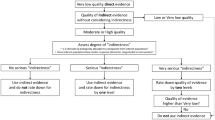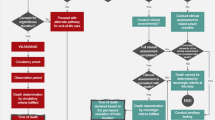Abstract
Substitute decision-makers for severely disabled neonates who can be kept alive but who will require constant medical interventions and will die at the latest in their teens are faced with a difficult decision when trying to decide whether to keep the infant alive. By and large, the primary focus of their decision-making centers on what is in the best interests of the newborn. The best-interests criterion, in turn, is importantly conditioned by quality-of-life considerations. However, the concept of quality of life is logically and ethically different for patients with a developing as opposed to a developed awareness. Unfortunately, this difference is ignored by current quality-of-life considerations, there are no quality-of-life measures that take this difference into account, and decision-making proceeds entirely without acknowledging this fact. This note outlines why this is a problem and why there is a need for a new set of tools that incorporates this distinction if the substitute decision-makers are to apply the best-interest criterion in a meaningful way.
Similar content being viewed by others
Notes
A rare childhood neurological disorder that causes degeneration in the part of the brain that controls motor movements and speech. Death usually occurs in the early teens.
A rare genetic disease characterized by the presence of extremely fragile skin and recurrent blister formation, resulting from minor mechanical friction or trauma. Death usually occurs before age ten.
“alles verloren ist, wenn die empirischen und daher zufälligen Bedingungen der Ausführung des Gesetzes zu Bedingungen des Gesetzes selbst gemacht” [77].
References
World Medical Association. International code of medical ethics. http://www.wma.net/e/policy/c8.htm. Accessed 14 May 2009.
Dutch penal code of 3 March 1881, Stb. 35, amended 6 December 1995, Stb. 592, Articles 293 and 294.
Belgium. Act on euthanasia (2002) 2:1.
University of Toronto. The childrens’ quality of life project. http://www.utoronto.ca/qol/children.htm. Accessed 14 May 2009.
Schlatter, D., M.T. Sanseverino, J.M. Schmitt, A. Fritsch, R.G. Kessler, P.M. Barrios, R.S. Palma-Dias, and J.A. Magalhães. 2008. Severe fetal hydrocephalus with and without neural tube defect: A comparative study. Fetal Diagnosis and Therapy 23(1): 23–29.
Spitzer, W., A. Dobson, and J. Hall. 1981. Measuring the quality of life of cancer patients: A concise QL-Index for use by physicians. Journal of Chronic Diseases 34: 585–597.
University of Toronto. Quality of Life Project. http://www.utoronto.ca/qol/ Accessed 24 July 2008.
Eiser, C., and R. Morse. 2001. Quality-of-life measures in chronic diseases of childhood. Health Technology Assessment 5(4): 1–157.
United States Department of Human Health and Services, PHS 1993. Quality of life assessment, practice, problems and promise. NIH Publication No. 93-3503.
Shumaker, S.A., and R. Berzon (eds.). 1995. The International assessment of health-related quality of life: Theory, translation, measurement and analysis. Oxford and New York: Rapid Communications.
Albrecht, G.L., and P.J. Devlieger. 1999. The disability paradox: High quality of life against all odds. Social Science and Medicine 48: 977–988.
Bowling, A. 1995. What things are important in people’s lives? A survey of the public’s judgments to inform scales of health related quality of life. Social Science and Medicine 41: 1447–1462.
Calman, K.C. 1984. Quality of life in cancer patients—an hypothesis. Journal of Medical Ethics 10: 124–127.
Carr, A.J., and I.J. Higginson. 2001. Measuring quality of life: Are quality of life measures patient centred? British Medical Journal 322: 1357–1360.
Cella, D.F., and D.S. Tulsky. 1990. Measuring quality of life today: Methodological aspects. Oncology 4: 29–38.
WHOQOL Group. 1994. The development of the WHO quality of life assessment instruments. In Quality of life assessment: International perspectives, eds. J. Orley and W. Kuyken, 41–57. Berlin: Springer-Verlag.
NHS. Organ donation—A protocol for adult intensive care units. www.library.nhs.uk/SpecialistLibrarySearch/Download.aspx?resID=155999. Accessed 12 May 2009.
Pentz, R.D., A.L. Flamm, R. Pasqualini, C.J. Logothetis, and W. Arap. 2003. Revisting guidelines for research with terminal wean and brain-dead participants. The Hastings Center Report 33(1): 20–26.
Castral, T.C., F. Warnock, A.M. Leite, V.J. Haas, and C.G. Scochi. 2008. The effects of skin-to-skin contact during acute pain in preterm newborns. European Journal of Pain 124: 464–471.
Johnston, C.C., F. Filion, M. Campbell-Yeo, C. Goulet, L. Bell, K. McNaughton, J. Byron, M. Aita, G.A. Finley, and C.D. Walker. 2008. Kangaroo mother care diminishes pain from heel lance in very preterm neonates: A crossover trial. BMC Pediatrics 8: 13.
Eriksson, M., H. Storm, A. Fremming, and J. Schollin. 2008. Skin conductance compared to a combined behavioural and physiological pain measure in newborn infants. Acta Paediatrica 971: 27–30.
Holsti, L., R.E. Grunau, T.F. Oberlander, and H. Osiovich. 2008. Is it painful or not? Discriminant validity of the behavioral indicators of infant pain BIIP scale. Clinical Journal of Pain 241: 83–88.
Lamau, M.-L., B. Cadore, and P. Boitte. 1997. From the ethical treatment of patients in a persistent vegetative state to a philosophical reflection on contemporary medicine. Theoretical Medicine 18: 237–262.
The Multi-Society Task Force on PVS. 1994. Medical aspects of the persistent vegetative state. New England Journal of Medicine 330(1499–1508): 1572–1579.
ANA Committee on Ethical Affairs. 1993. Persistent vegetative state: Report of the american neurological association committee on ethical affairs. Annals of Neurology 33: 386–390.
Schnakers, C., and N.D. Zasler. 2007. Pain assessment and management in disorders of consciousness. Current Opinions in Neurology 206: 620–626.
BMA Medical Ethics Committee. 1993. Guidelines on persistent vegetative state. Bulletin of Medical Ethics 89: 8–10.
The vegetative state. Guidance on diagnosis and management: Report of a working party of the Royal College of Physicians. 2003. Royal College of Physicians: London.
Kant, I. 1781. Kritik der Reinen Vernunft. Richard Hoyer, ed. 1975 edition. Köln: Atlas-Verlag.
Smith, E., and M. Delargy. 2005. Locked-in syndrome. British Medical Journal 330: 406–409.
K.J. Berkely. 1991. Suspension of neural pathways for pain and nociception. Journal of Cardiovascular Electrophysiology 2(supplement): SI3–SJ7.
Rhem, P., and H. Liljenström. 1997. On the coevolution of cognition and consciousness. Journal of Theoretical Biology 187: 601–612.
Shettleworth, S.J. 2001. Animal cognition and animal behaviour. Animal Behaviour 61: 277–286.
Craig, K.D. 1994. Emotional aspects of pain. In Textbook of pain, 3rd ed, ed. P.D. Wall, and R. Melzack, 261–274. Edinburgh: Churchill Livingston.
Edelman, G.M., and G. Tononi. 2000. Universe of consciousness. United States of America: Basic Books.
Eichenbaum, H. 1997. Declarative memory: Insights from cognitive neurobiology. Annual Review of Psychology 48: 547–572.
Lindahl, B.I.B. 1997. Consciousness and biological evolution. Journal of Theoretical Biology 187: 613–629.
Criminal code of Canada Ss. 215–229.
Addington-Hall, J., and L. Kalra. 2001. Measuring quality of life: Who should measure quality of life? British Medical Journal 322: 1417–1420.
Manara, A.R., J.A. Pittman, and F.E. Braddon. 1998. Reasons for withdrawing treatment in patients receiving intensive care. Anaesthesia 53: 523–528.
Pellegrino, E.D. 2000. Decisions to withdraw life-sustaining treatment: A moral algorithm. JAMA 283: 1065–1067.
Broome, J. 2004. Weighing lives. Oxford: Oxford University Press.
Higginson, I.J., and A.J. Carr. 2001. Using quality of life measures in the clinical setting. British Medical Journal 3227297: 1297.
Re S.D. 1983 3 W.W.R. 618 B.C.S.C.
E. (Mrs.) v. Eve, [1986] 2 S.C.R. 388.
Gwet, K. 2001. Handbook of inter-rater reliability. Gaithersburg: StatAxis Publishing.
Collins, R., R.A.J. Lanham, and B.J. Sigford. 2000. Reliability and validity of the Wisconsin HSS quality of life inventory in traumatic brain injury. Journal of Head Trauma Rehabilitation 15(5): 1139–1148.
Parfit, D. 1984. Reasons and persons. Oxford: Oxford University Press.
Kagan, J. 1981. The second year: The emergence of self-awareness. Cambridge: Harvard University Press.
Hufford, B.J. 2000. Self-awareness of neuropsychological deficits in children and adolescents with epilepsy. Ph.D. thesis, Purdue University.
Poltorak, D.Y., and J.P. Glazer. 2006. Development of children’s understanding of death: Cognitive and psychodynamic considerations. Child and Adolescent Psychiatric Clinics of North America 15(3): 567–573.
Slaughter, V. 2005. Young children’s understanding of death. Australian Psychologist 403: 179–186.
Spinetta, J. 1974. The dying child’s awareness of death. Psychological Bulletin 8: 256–260.
Reilly, T.P., J.E. Hasazi, and L.A. Bond. 1983. Children’s conceptions of death and personal mortality. Journal of Pediatric Psychology 81: 21–31.
O’Neill, O. 2001. Practical principles and practical judgment. Hastings Center Report 31(4): 15–23.
Hodgkinson, C. 1996. Administrative philosophy. Oxford: Pergamon.
Kluge, E.-H. 2004. Competence, capacity and informed consent: Beyond the cognitive-competence model. Canadian Journal on Aging 243: 85–94.
Shivaswamy, K.N., T.K. Sumathy, A.L. Shyamprasad, and C. Ranganathan. 2009. Squamous cell carcinoma complicating epidermolysis bullosa in a 6-year-old girl. International Journal of Dermatology 48(7): 731–733.
Malone, M.M. 1982. Consciousness of dying and projective fantasy of young children with malignant disease. Journal of Developmental and Behavioral Pediatrics 3(2): 55–60.
Spinetta, J.J., D. Rigler, and M. Karon. 1973. Anxiety in the dying child. Pediatrics 52(6): 841–845.
Spinetta, J.J. 1974. The dying child’s awareness of death: A review. Psychological Bulletin 81(4): 256–260.
Waechter, E.H. 1971. Children’s awareness of fatal illness. American Journal of Nursing 71: 1168–1172.
Ayer, A. J. 1946. Other minds. Supplement to the proceedings of the Aristotelian Society 20: 188–197.
Malcolm, N. 1958. Knowledge of other minds. Journal of Philosophy 55(23): 969–978.
Price, H.H. 1938. Our evidence for other minds. Philosophy 13: 425–436.
Putnam, H. 1975. Other minds. In Mind, language and reality, 342–361. Cambridge: Cambridge University Press.
Wittgenstein, L. 1953. Philosophical Investigations. Eds. G.H. von Wright, R. Rhees, and G.E.M. Anscombe. Blackwell: Oxford.
Øhrstrøm, P., and P.F.V. Per Hasle. 1995. Temporal logic: From ancient ideas to artificial intelligence. Dordrecht: Springer.
Gaskin, R. 1995. The seabattle and the master argument: Aristotle and Diodorus Cronus on the metaphysics of the future. Berlin: Walter de Gruyter &Co.
Belnap, N., and M. Green. 1994. Indeterminism and the thin red line. In Philosophical perspectives, vol. 8, ed. J. Tomberlin, 365–388. Atascadero, CA: Ridgeview Publishing Company.
Lukasiewicz, J. 1967. Three-valued logic. In Polish logic, ed. S. McCall., 16–18. Oxford: Oxford University Press.
Prior, A.N. 1953. Three-valued logic and future contingents. The Philosophical Quarterly 23(3): 317–326.
MacFarlane, J. 2003. Future contingents and relative truth. The Philosophical Quarterly 53(212): 321–326.
Weischedel, W. (ed.). 1977. Immanuel Kant: Werke in zwölf Bänden. Frankfurt am Main: Suhrkamp.
Ravens-Sieberer, U., and M. Bullinger. 1998. Assessing health-related quality of life in chronically ill children with the German KINDL: First psychometric and content analytical results. Quality of Life Research 75: 399–407.
Bullinger, M., S. Schmidt, and C. Petersen. 2002. DISABKIDS Group. Assessing quality of life of children with chronic health conditions and disabilities: A European approach. International Journal of Rehabilitation Research 253: 197–206.
Kant, I. Über den Gemeinspruch: Das mag in der Theorie richtig sein, taugt aber nicht fur die Praxis. http://virt052.zim.uni-duisburg-essen.de/kant/aa08/277.html. Accessed 12 May 2009.
Author information
Authors and Affiliations
Corresponding author
Rights and permissions
About this article
Cite this article
Kluge, EH.W. Quality-of-life considerations in substitute decision-making for severely disabled neonates: The problem of developing awareness. Theor Med Bioeth 30, 351–366 (2009). https://doi.org/10.1007/s11017-009-9119-z
Published:
Issue Date:
DOI: https://doi.org/10.1007/s11017-009-9119-z




